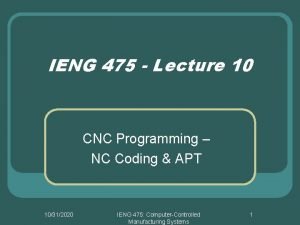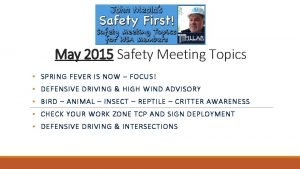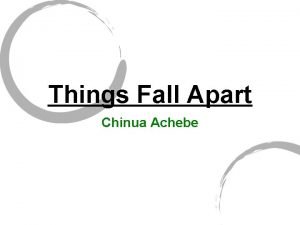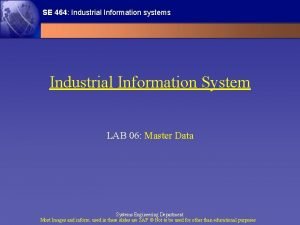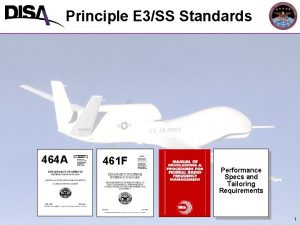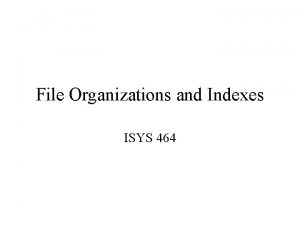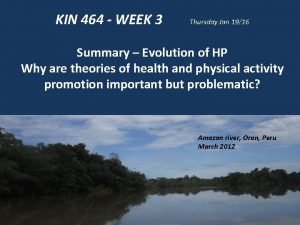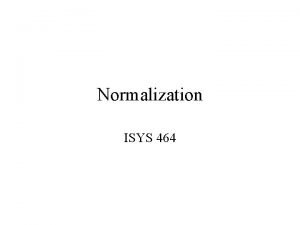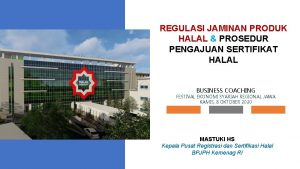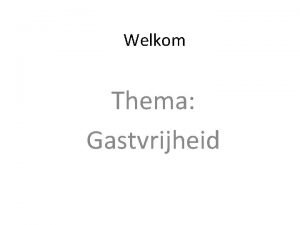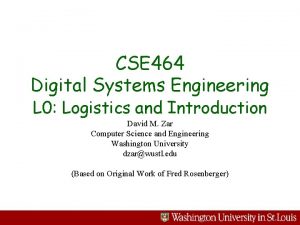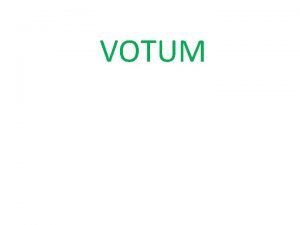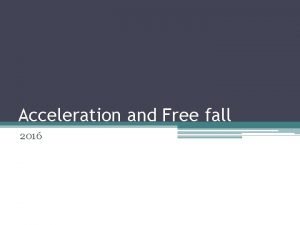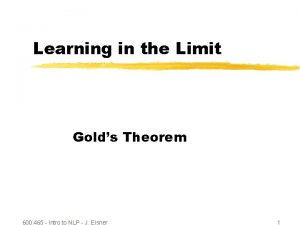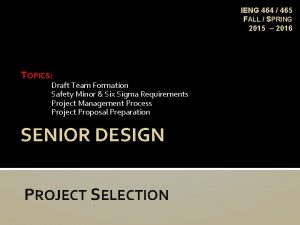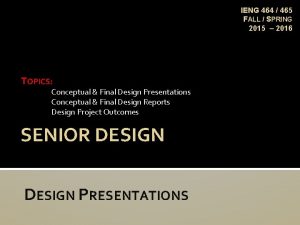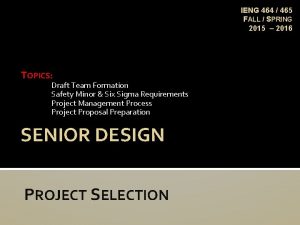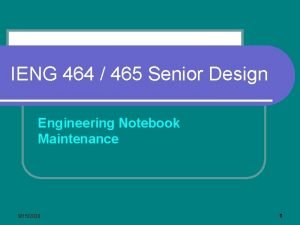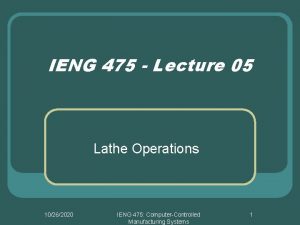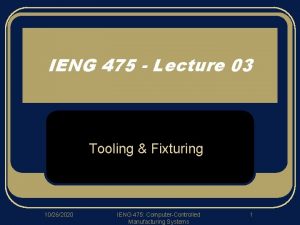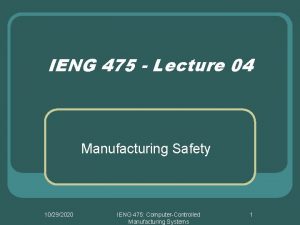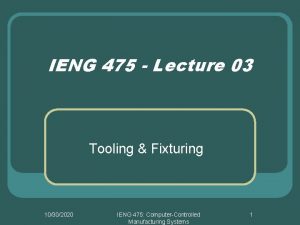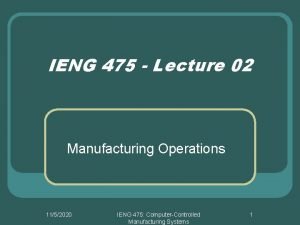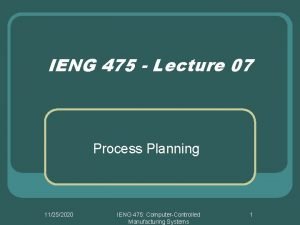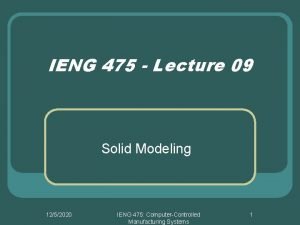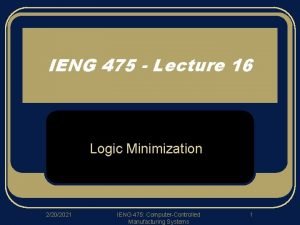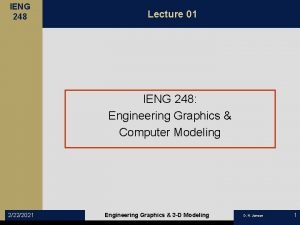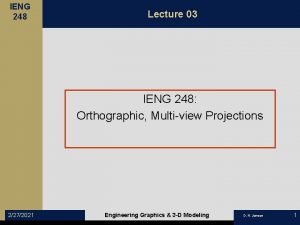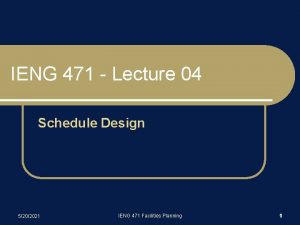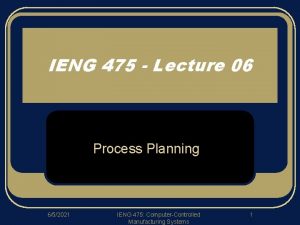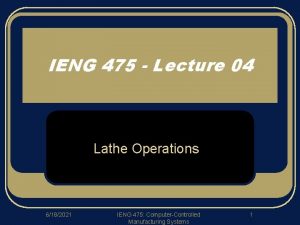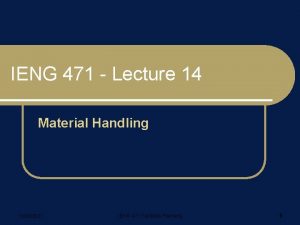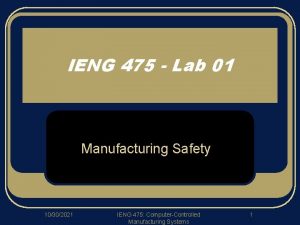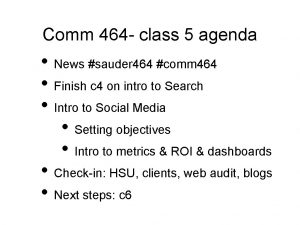IENG 464 465 FALL SPRING 2015 2016 TOPICS





















- Slides: 21

IENG 464 / 465 FALL / SPRING 2015 – 2016 TOPICS: Draft Team Formation Safety Minor & Six Sigma Requirements Project Management Process Project Proposal Preparation SENIOR DESIGN INTRODUCTION TO SENIOR DESIGN I, II

Lecturer � Lectures: D. H. Jensen ▪ 308 Industrial Engineering & Research Bldg (IER) ▪ (605) 394 -1278 ▪ dean. jensen@sdsmt. edu Office Hours: ▪ Tu, Th: 9: 30 AM – 10: 50 AM ▪ Appt. http: //jensen. sdsmt. edu/Schedule. htm Class Meetings: ▪ Thursday: 11: 00 - 11: 50 ▪ *Tuesday: 11: 00 - 11: 50 IER 205 Class Website: ▪ http: //jensen. sdsmt. edu/IENG 464 -465 Required Material: ▪ Engineering Problems Paper – 8 -1/2" x 11", three hole drilled, ruled five squares/division, 50 pp. (approx. ). 9/5/2021 IENG 471 Facilities Planning 2

PROCESS OVERVIEW –START PROJECT � Prioritize/Draft Project & Teams Ideally four people per team � Select Project & Teams Project & team must be viable – no guarantees � Meet With Client, Negotiate & Agree On: “Triple Constraint” ▪ Timing ▪ Budget ▪ Functionality Document in a brief project charter in your Engineering Notebook � Prepare & Submit Project Proposal Formal document that includes: ▪ ▪ Background & Problem Statement Scope of Work Team Qualifications Project Planning

PROCESS OVERVIEW –START DESIGN � Manage Project – (Select & Implement Appropriate Model) � Design � Research, Prototype, Test, Refine Meetings � Bi-Weekly Progress Report (E-mail) ▪ See Schedule Student Team Meetings ▪ Client – Team Meetings ▪ Project Status Meetings ▪ Student Team Meetings ▪ Project Management Meetings Document each in your Engineering Notebook Conceptual Design Presentation & Report Formal document & presentation that includes: ▪ Background & Problem Statement ▪ Design Approach & Results ▪ Recommended Concept(s) for Implementation ▪ Implementation/Testing Plan ▪ Implementation/Testing Budget

PROCESS OVERVIEW –IMPLEMENT / TEST � Manage Project – (Select & Implement Appropriate Model) � Implement Design � Construct, Test, Report & Document in your Engineering Notebook Meetings � Bi-Weekly Progress Report (E-mail) ▪ See Schedule Student Team Meetings ▪ Client – Team Meetings ▪ Project Status Meetings ▪ Student Team Meetings ▪ Project Management Meetings Document each in your Engineering Notebook Final Design Presentation & Report Formal document & presentation that includes: ▪ Problem Statement & Constraints ▪ Methodology & Analysis ▪ Design Discussion & Project Results ▪ Address “Triple Constraint” performance! ▪ Recommendations & Conclusions

ASSESSMENT **New Requirement: scheduled progress meetings will include paper Team Member Assessments, too.

Questions & Issues �Students with special needs or requiring special accommodations should contact the instructor, Dr. Jensen, at 393 -5074 and/or the campus ADA coordinator, Megan Reder. Schopp, at 394 -6988 at the earliest opportunity. 9/5/2021 IENG 471 Facilities Planning 7

IEEM PROJECT & PRESENTATION RUBRIC 3 2 1 0 Can identify both engineering and other environmental variables apropos to issue Root cause(s) of problem determined Wide range of appropriate evidence sources used Can identify engineering related environmental variables apropos to the issue Root cause(s) looked for, but process ended too soon Some appropriate evidence sources used Can identify environmental variables, but unsure which are related to the issue Multiple symptoms aggregated as problem Evidence sources used, but not entirely appropriate to issue Fails to identify environmental variables or see the need for these variables First symptom seen “defined” as the problem No or inappropriate evidence sources used Choose Appropriate Tools Both quantitative and qualitative tools used as appropriate Uses quantitative tools as appropriate Uses tools, but tools are not appropriate to issue No tools or frameworks used Develop a Chain of Evidence Clear links – uses data in its context and connects data using appropriate tools Links – uses data and connects using appropriate tools Almost links – based on inadequate data or tools No links – no chain of evidence Recommendation links to chain of evidence but comes from the “canned” set of alternatives Recommendation does not link to chain of evidence No recommendation made Make Choices Recommendation links to chain of evidence and shows consideration of additional alternatives Solution(s) considers implementation concerns and economic impact Solution(s) is technically feasible, but no additional concerns are considered Solution(s) is not feasible Reasonable Solutions Solution(s) considers implementation concerns, level of actual improvement, economic impact, social impact, and ethics Presentation of argument demonstrates problem definition, chain of evidence, analysis, and recommendation in easy to follow manner Well organized, uses professional language and grammar, appropriate use of tables, figures, etc, aimed at audience Presentation of argument demonstrates problem definition, chain of evidence, analysis, and recommendation but not easy to follow Somewhat organized, mostly uses professional language and grammar, appropriate use of tables, figures, etc, mostly aimed at audience Presentation of argument demonstrates only parts of: problem definition, chain of evidence, analysis, and recommendation Presentation of argument cannot be followed by reasonable audience member Somewhat organized, poor grammar, uses texting language, needed figures, tables, etc present and appropriate, not aimed at audience No organization, poor grammar, uses texting language, needed figures, tables, etc not present, not aimed at audience Context Account for Environmental Variables Define Problem Gather Evidence Analysis Recommendations Communication Clarity of Argument Professional Presentation

POTENTIAL DESIGN PROJECTS Starting Point for Forming Teams

Team Composition � Team Size Limitations Teams can fire non-performers ▪ Must consult with Dr. Jensen to fire ▪ Means your team is a person smaller ▪ Means a fired person is going to have to work REAL hard to pass Ideal Team Size: ▪ ▪ Single discipline team: Multi-discipline team: Minimum team size: There is no team of size 1 4 persons 4 – 6 persons 3 persons (or 2, at least at the start of Sr. Design, anymore) Be wary of “waterfall” design models for “everything” ▪ Waterfall models have their place – some things cost $$$ ▪ Very few designs really can’t be prototyped inexpensively ▪ Avoid large projects that have leaders without strong project management skills especially if the waterfalls can’t be done concurrently! ▪ Avoid any project that doesn’t require every one to be responsible for progress reporting 9/5/2021 10

EXTENDING THE LOW COST CNC ROUTER & GLOBAL SUPPLY CHAIN � Lack of equipment for exploring CNC programming, process planning and general manufacturing engineering activities hinders STEM education in some cultures/lands � The goal of this project will be to extend, construct and demonstrate a robotic gripper (and s/w and component extensions) that is interchangeable with the CNC Router and an effective supply chain for meeting the global technical education needs. � Considerations: Low cost system (approximately $1 000 USD or less) Open-source software and hardware Excellent construction documentation in multiple languages Development of small, low-cost products demonstrating basic operations Development of a global supply chain for sourcing the original equipment and replacement/expansion parts

CNC VERTICAL MILL WORKSTATION PROJECT � In order to fit the planned equipment for the Manufacturing/ Innovation Laboratory into the new, Library basement space, it will be necessary to redesign the CNC Vertical Mill workstation for a smaller footprint. � The current workstation has an approximate 8’ x 3’ footprint (without operator), is not ADA compliant, and has a horizontal layout. � The redesigned workstation should: Fit an approximate 4’ x 3’ footprint (without operator), using a more vertical layout Accommodate wheelchair access Demonstrate improved physical and cognitive ergonomics, both for operation and for assembly/relocation Considering improved guarding and safety of operation Be easily relocatable with respect to the laboratory location Be repeat ably relocatable with respect to the laboratory conveyor and robotic tending equipment.

BHW ERGONOMIC ADJUSTABLE EASEL KIT DESIGN COMPLETION PROJECT � Black Hills Works supports a number of clients with differing physical needs. There is a pressing need for a means to complete the existing redesign of an electrically adjustable easel to different heights and tilt angles. � The current design is functional, is powered by rechargeable drill battery, has an approximate 4’ x 3’ footprint (without operator), and is ADA compliant. However it needs optimization and process planning for BHW staff to reproduce and operate. � The redesigned easel will require: Optimal, final redesign/development for ergonomic operations, including ADA/wheelchair accessibility and safety. Completion of controls for configuration, based on solid physiological and ergonomic criteria, and appropriate to the identified client population. At least two iterations of purchase, construction, operational and usability testing of the retrofit kit(s) to meet customer constraints and needs prior to the Spring Design Fair. Proposal of a cost-effective system for kit production. Possible submission of the final design for NISH Competition.

CNC LATHE (TURNING CENTER) WORKSTATION PROJECT � In order to fit the planned equipment for the Manufacturing/ Innovation Laboratory into the new, Library basement space, it will be necessary to redesign the CNC Lathe workstation (called a TURNING CENTER) for a smaller footprint. � The current workstation has an approximate 6’ x 3’ footprint (without operator), is not ADA compliant, and has a horizontal layout. � The redesigned workstation should: Fit an approximate 4’ x 3’ footprint (without operator), using a more vertical layout Accommodate wheelchair access Demonstrate improved physical and cognitive ergonomics, both for operation and for assembly/relocation Considering improved guarding and safety of operation Be easily relocatable with respect to the laboratory location Be repeat ably relocatable with respect to the laboratory conveyor and robotic tending equipment.

CNC ROUTER/CONVEYOR WORKSTATIONS PROJECT � In order to fit the planned equipment for the Manufacturing/ Innovation Laboratory into the new, Library space, it will be necessary to redesign the lab’s conveyor and add two or more CNC router workstations within the existing footprint. � The current workstation has an approximate 12’ x 8’ footprint (without operator or attaching workstations. ) This project will: Add two or more CNC Routers, each with an approximate 21” x 22” footprint (without operator), these should be constructed and re/dis-mountable for demonstrations Add a Scorbot ER V+ robot on a 56” x 10” linear slide for CNC Router tending operations Add a robotic controller for the ER V+ robot Add storage below the CNC Routers/Robot for standard book boxes of raw stock materials Demonstrate improved physical and cognitive ergonomics, both for operation and for assembly/relocation Be repeat-ably relocatable with respect to the laboratory CNC Vertical Mill/Lathe, AS/RS, and robotic tending equipment.

Stovetop Access � There a lot of products on the market geared toward preventing children from accessing stovetops, but these products become impractical for adults over 3 feet tall! � Many of the people we support require close supervision when the stove is in operation. � Problems results when the person independently accesses the stove or when the support staff has to step away to respond to an emergency. � This project is the completion of a design created last year. An interested team will need to view the existing design and Arrange for construction and testing of a full scale prototype Create detailed production plans for BHW staff to reproduce, including cost estimation Fully document the production and operation methods for the design. This project is available, but is not linked on the course Materials page. See instructor for existing documentation.

ENGINEERING NOTEBOOK Care and Maintenance Requirements

Engineering Notebooks � Individual Responsibility Must be legally constructed ▪ Pages can’t be re-sequenced ▪ Missing pages are easily identified as such Must be legally documented ▪ Entries must be accurate ▪ Entries must be chronological ▪ Entries of importance should be witnessed Examples to document: ▪ Meeting times, places, attendees, topics ▪ Relevant phone conversations ▪ Relevant expenditures, mileage ▪ Design principles, concepts, sketches ▪ Engineering results, decisions, rationale Copies are placed in Project Notebook regularly 9/5/2021 18

Engineering Notebooks � Engineering Notebooks are a permanent record for legal purposes Notebooks have a durable cover Pages are sewn or perfect bound (not loose-leaf or spiral 9/5/2021 bound) Entries are made with permanent methods Entries are made in sequential order & dated Errors are lined out, but not obliterated Loose material is attached within the notebook pages (if possible), or referenced within (if not) 19

Using Your Engineering Notebook � Blow-by-blow Documentation Corner of page ▪ Date & time ▪ Location ▪ Personnel present Title of task ▪ ▪ Experimental conditions, equipment ID numbers Blow-by-blow record of process Sketches of experimental setup / design Summarize major decisions / results Single line ends an activity, Double line ends day 9/5/2021 20

Eng. Notebook Entry Example 10/1/99 Team Mtg 4: 15 pm Agenda: George, Jane, Judy (Elroy absent) Clodfelter’s Bar & Grill Refreshments Brainstorming Material Purchase - Discussed cost vs. refreshment performance - George presented analysis showing non-linearity at high $ end - Decision to invent more effective beverage - Brainstormed concepts - Reduced water content - Increased hops in raw stock - Decision to invest in further research - Planned expenditure of $25. 00 - Actual expenditure of $26. 75 due to heavy tipping 9/5/2021 Refresh. Level Cost ($) 21
 5 letter words with ieng
5 letter words with ieng Seasons months
Seasons months Cast of spring, summer, fall, winter... and spring
Cast of spring, summer, fall, winter... and spring Spring safety topics for meetings
Spring safety topics for meetings Spring break 2015
Spring break 2015 Theme of things fall apart
Theme of things fall apart Theme of things fall apart
Theme of things fall apart Industrial information system
Industrial information system Isys 464
Isys 464 Mil std 461 464
Mil std 461 464 Isys 464
Isys 464 Kin 464
Kin 464 Er diagram of online shopping
Er diagram of online shopping Exam 70-464 training kit
Exam 70-464 training kit Kma 464 tahun 2020
Kma 464 tahun 2020 Opwekking 352
Opwekking 352 Cse logistics
Cse logistics Kin 464
Kin 464 Isys 464
Isys 464 Drinkgoed duitsland
Drinkgoed duitsland Free fall 2016
Free fall 2016 600-465
600-465
